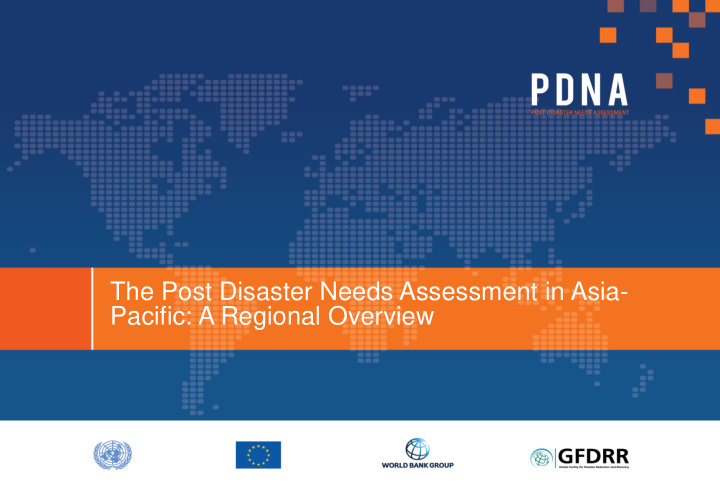



The Post Disaster Needs Assessment in Asia- Pacific: A Regional Overview
21 PDNAs conducted in the Asia-Pacific region Country Event Year Myanmar Flood 2015 Nepal Earthquakes 2015 Since 2005 Out of these 21 have been 48 PDNAs have Vanuatu Tropical Storm 2015 been conducted conducted in Fiji Cyclone 2013 the Asia-Pacific in 40 countries Samoa Cyclone 2012 region Bhutan Earthquake 2011 Pakistan Flood 2011 Thailand Flood 2011 Laos PDR Typhoon 2011 Kyrgystan Flood 2010 Pakistan Flood 2010 Cambodia Cyclone 2009 Laos PDR Cyclone 2009 Indonesia Earthquake 2009 Samoa Tsunami 2009 Philippines Cyclone 2009 Bhutan Earthquake 2009 India Flood 2008 Myanmar Cyclone 2008 Bangladesh Cyclone 2007 Pakistan Earthquake 2005
Evolution of the PDNA Methodology
Post-crisis Cooperation Agreement and Guidelines On 25 September 2008, the UNDG, EU and WB signed a Joint Declaration on Post-Crisis Assessments and Recovery Planning - PDNA Volumes A and B - Disaster Recovery Framework Presented in September 2014 at the Second World Reconstruction Conference; officially launched at the Sendai World Conference on Disaster Risk Reduction on 14 March 2015
Why conduct a PDNA: Rationale Harmonize Common platform Government led methodologies, for coordinated process toolkits and capacity action building approach Tool for resource People-centred Enhance country mobilization and inclusive approach resilience to crisis recovery to the civil society programming
PDNA Actors Who conducts a PDNA: Key actors National Disaster National Government Management Systems, and its Institutions the Line Ministries and the Local Governments PDNA Actors Civil society, Private EU, WB, UNDG and other Sector, Technical and International Partners Academic Institutions
PDNA Activation Coordination In country communication between EU, WB, UN of with Gov. and a possible request for a PDNA, reported among immediately to HQ. partners Official request from the Government and joint decision to activate a PDNA including the designation of the national lead ministry. Deployment of a Planning Mission and formulation of the TORs for the PDNA. Definition of the support that Government and partners will provide to the process.
Tools and mechanisms for the PDNA Agreed methodology for the assessment: PDNA Vol. A 18 Sector-specific guidelines: PDNA Vol. B A Disaster Recovery Framework: DRF Training package Roster of experts
PDNA Coordination Structure High Level Management (Team Provides Strategic Guidance) PDNA Coordination Sector Teams Team
Typical Sectors and Subsectors PRODUCTIVE SOCIAL INFRASTRUCTURE Agriculture Housing Water & Sanitation Commerce Community infrastructure Education Industry Energy Health Culture Tourism Transport Telecommunications CROSS-CUTTING GENDER GOVERNANCE ENVIRONMENT DISASTER RISK EMPLOYMENT AND REDUCTION LIVELIHOODS Note: The diagram above illustrates the typical sectors that are assessed in the PDNA, this can vary from country to country.
The Role of the EU, UNDG and WB Sectors Multi sectorial experts Technical support to deployment for coordination implement post-disaster and recovery sector assessment Tripartite Partners Funding PDNAs and Training and Capacity reconstruction and recovery Building activities
PDNA implementation process Establish the PDNA assessment team Conduct training/orientation on PDNA Data collection and validation, draft sectorial reports Consolidation and analysis of Sector effects, impact and needs Formulating the Recovery Strategy Resource mobilization and implementation mechanism
Key Considerations What is a PDNA? • Types of disasters impact sectors differently eg. earthquakes impact the housing (social) and roads (infrastructure) the most; floods and cyclones tend to impact agriculture (productive), livelihoods and environment (cross-cutting) more • The country context is critical in calculating recovery needs eg. in Bhutan and Nepal earthquakes, restoration of cultural heritage is important for physical as well as psycho-social needs • To analyse pre-and-post-disaster effects, baseline data must be available and collected beforehand, usually by the Government • In addition to desk review, the assessment must include field visits to validate data and ensure the human dimension • The PDNA highlights underlying risks and vulnerabilities that pose a threat to future disasters, therefore, recovery needs include components of disaster risk reduction or build back better • Disaggregated data from enough disasters show that women are disproportionately affected by disasters, gender has emerged as an important cross cutting issue to address in recovery
Strategic results of cooperation Strategic results of cooperation • PDNAs led to national assessment instruments adapted and developed in: Indonesia, Laos, Philippines, Nepal, Kyrgyzstan, Central America, Caribbean, Jamaica • Used for small and large disasters to form recovery and reconstruction plans : Fiji, Samoa, Caribbean islands • Institutionalized process by law: Indonesia, Nepal • Recovery and Reconstruction done with a focus on reducing risks , “building back better ” : Indonesia • Led to complete review of strategy and investment in Disaster Risk Reduction: Indonesia, Bangladesh, Nigeria • Post-disaster recovery led to conflict reduction : Indonesia (Aceh) • Concept of recovery moving from focus on physical reconstruction to focus on recovery from impacts on human development , welfare, livelihoods and capacities: Fiji, Samoa, Malawi • Capacity building on conducting the PDNA: Trainings for representatives from ASEAN member states (July 2015) and SAARC disaster management authorities (September 2015) held
ASEAN Disaster Recovery Reference Guide What is a PDNA? • ASEAN-UN Strategic Plan of Action on Disaster Management: MOU signed on 27 November 2007 • Joint Declaration on ASEAN-UN Collaboration on Disaster Management to support the implementation of the AADMER Work Plan, 2010-15 • UNDP leading Recovery component: ASEAN Disaster Recovery Reference Guide, first draft by end 2015 • The pre-disaster recovery arrangements and post-disaster recovery plans include the conduct of PDNAs and building capacities in the region to undertake PDNAs
Looking Ahead What is a PDNA? • Finalization of ASEAN Disaster Recovery Reference Guide and roll-out of PDNA trainings at the country level • Hands on training for SAARC country representatives on conducting PDNA and RARR • Creation of roster of sector experts in the Asia- Pacific region • Greater use of innovative tools such as space technology, crowdsourcing applications and others developed by ESCAP into the PDNA methodology
Recommend
More recommend